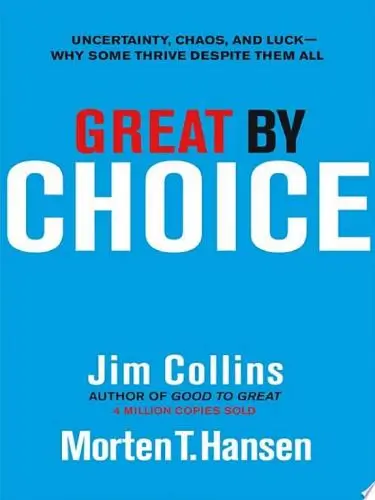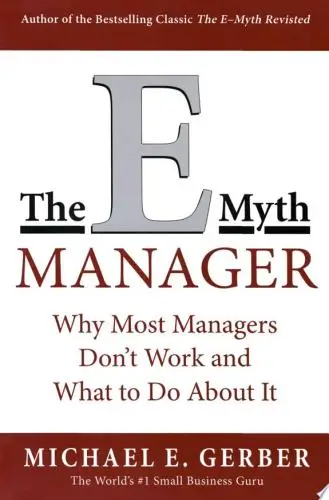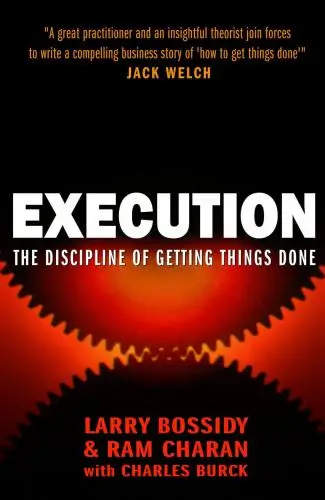Execution
The Discipline of Getting Things Done
What's it about?
Execution by Larry Bossidy and Ram Charan dives deep into the core principle that the true test of a leader is the ability to execute. It's not just about the strategies you create but how well you can implement them. The authors, with their extensive experience, unravel the critical importance of execution in the success of a business, emphasizing that it's a discipline and integral part of strategy. This book offers a blend of real-world insights and practical advice, making it a must-read for leaders who aim to bridge the gap between promises and results.
About the Author
Larry Bossidy is a distinguished corporate executive and author, best known for his book "Execution: The Discipline of Getting Things Done." Co-authored with Ram Charan, the book emphasizes the importance of execution in business success. Bossidy's insights draw from his extensive experience as CEO of Honeywell International and AlliedSignal.
10 Key Ideas of Execution
Clarify Your Vision and Strategy
A clear vision and strategy provide a roadmap for achieving organizational goals.
It's essential to articulate what the organization aims to achieve and how it plans to get there.
This clarity enables leaders and employees to align their efforts towards common objectives, ensuring that everyone is working in the same direction.
By setting specific, measurable, achievable, relevant, and time-bound (SMART) goals, organizations can break down their vision into actionable steps, making execution more manageable and effective.
Learn DeeperDefine Your Vision: Start by asking yourself where you want your organization or project to be in the next 5, 10, or even 20 years. Make this vision as clear and specific as possible. For example, instead of saying 'I want my business to grow,' specify 'I aim for my business to expand its services to three new cities and double its customer base within the next five years.'
Develop a Strategy: Once your vision is clear, brainstorm the steps needed to achieve it. This could involve market research, expanding your team, increasing marketing efforts, or developing new products. Outline these steps in a strategic plan.
Set SMART Goals: Break down your strategy into specific, measurable, achievable, relevant, and time-bound goals. For instance, if part of your strategy involves expanding your team, a SMART goal could be 'Hire three new marketing specialists by the end of Q2 to support our expansion into new markets.'
Communicate and Align: Share your vision, strategy, and goals with your team. Ensure everyone understands their role in achieving these objectives. Regular meetings or updates can help keep everyone aligned and focused.
Monitor and Adjust: Regularly review your progress towards your goals. Be prepared to adjust your strategy if circumstances change or if you're not progressing as expected. Flexibility is key to overcoming obstacles and staying on track.
- Example
A small tech startup aims to become a leading provider of innovative educational software within the next five years. The founder defines a clear vision: 'To empower educators and students with accessible, cutting-edge technology that enhances learning outcomes.' The strategy involves developing a unique software platform, securing partnerships with schools and educational institutions, and launching targeted marketing campaigns. SMART goals include 'Complete the first version of the software by Q3, secure at least two partnerships by Q4, and achieve a user base of 10,000 by the end of the first year.'
- Example
A local non-profit organization dedicated to environmental conservation sets a vision to significantly reduce plastic waste in their community over the next decade. Their strategy includes public awareness campaigns, lobbying for local legislation against single-use plastics, and organizing community clean-up events. SMART goals might be 'Increase community engagement by 50% through social media campaigns within six months' and 'Partner with 10 local businesses to reduce plastic usage by the end of the year.'
Foster a Culture of Execution
Creating a culture that prioritizes execution involves embedding it into the organization's DNA.
This means valuing results over processes, encouraging accountability at all levels, and rewarding those who consistently deliver on their commitments.
A culture of execution empowers employees, fosters a sense of ownership, and drives engagement by showing team members that their contributions directly impact the organization's success.
Cultivating this environment requires leadership to lead by example, demonstrating a commitment to execution in their actions.
Learn DeeperSet Clear Expectations: Start by clearly defining what success looks like for each role within your team or organization. Make sure everyone understands not just their tasks, but how these contribute to the larger goals.
Encourage Open Communication: Foster an environment where feedback is welcomed and valued. Regular check-ins and open-door policies can help ensure that everyone feels comfortable discussing progress and obstacles.
Reward Results: Implement a recognition system that rewards individuals and teams who meet or exceed their goals. This could be through public acknowledgment, bonuses, or other incentives that motivate continued excellence.
Hold Everyone Accountable: Ensure that there are clear consequences for not meeting expectations, but also provide support and resources to help individuals improve. Accountability should be applied consistently across all levels of the organization.
Lead by Example: Demonstrate your commitment to execution through your actions. Be proactive in addressing issues, meeting your own goals, and supporting your team in achieving theirs.
- Example
A software development company implements a monthly showcase where teams present completed projects and outline how these contribute to the company's strategic objectives. This not only rewards results but also reinforces the importance of execution in achieving company goals.
- Example
A retail manager holds weekly team meetings to discuss progress towards sales targets, offering support and resources to those who are struggling, and publicly acknowledging those who have exceeded their goals. This approach encourages accountability and motivates the team to focus on execution.
Develop and Support Your Leaders
Leaders play a crucial role in driving execution.
Investing in leadership development ensures that your leaders have the skills, knowledge, and mindset needed to effectively guide their teams towards achieving strategic goals.
This includes training in areas such as decision-making, strategic thinking, and people management.
Supporting leaders also means providing them with the resources they need to succeed, including access to information, authority to make decisions, and feedback on their performance.
Learn DeeperIdentify Leadership Potential Early: Keep an eye out for employees who demonstrate initiative, strong communication skills, and a knack for problem-solving. Offer them opportunities for leadership training and mentorship programs to cultivate these skills further.
Create a Leadership Development Program: Design a program that covers key areas such as strategic planning, effective communication, and team management. Include workshops, seminars, and shadowing opportunities with senior leaders to provide hands-on experience.
Encourage Open Communication: Foster an environment where leaders feel comfortable sharing their challenges and successes. Implement regular check-ins or feedback sessions to discuss progress, obstacles, and areas for improvement.
Provide Access to Resources: Ensure that your leaders have what they need to succeed. This could mean access to industry reports, financial data, or even software tools that can help them make informed decisions.
Celebrate Successes and Learn from Failures: Recognize and reward the achievements of your leaders and their teams. Equally important, create a culture where mistakes are seen as learning opportunities, not just failures.
- Example
A tech startup implements a 'Future Leaders' program, where high-potential employees are paired with mentors from the senior management team. Over a year, these employees attend leadership workshops, lead project teams, and receive regular feedback on their progress.
- Example
A retail chain introduces a monthly 'Leadership Circle' meeting where store managers share best practices, discuss challenges, and brainstorm solutions. This initiative not only supports the development of current leaders but also encourages a culture of continuous improvement and collaboration.
Link Strategy and Execution with Clear Objectives
To successfully execute a strategy, it's vital to translate high-level strategic goals into clear, actionable objectives.
This involves breaking down the strategy into smaller, manageable tasks and assigning them to the appropriate teams or individuals.
By establishing clear objectives, organizations can monitor progress, make necessary adjustments, and ensure that every action taken is aligned with the overarching strategy.
This linkage between strategy and execution helps maintain focus and drives momentum towards achieving long-term goals.
Learn DeeperSet Specific Goals: Break down your overarching strategy into specific, measurable goals. For instance, if your strategy is to increase market share, a specific goal could be to increase customer base by 10% within the next year.
Assign Clear Responsibilities: Once you have your goals set, assign clear responsibilities to team members or departments. Make sure everyone knows what they are accountable for and by when. This clarity will drive action and accountability.
Regular Check-ins: Schedule regular meetings to review progress towards the goals. This keeps the team focused, allows for adjustments in strategy if necessary, and maintains momentum.
Celebrate Milestones: Recognize and celebrate when milestones towards the larger goal are achieved. This boosts morale and keeps the team motivated towards the next target.
- Example
A software development company wants to launch a new app in six months. The strategy is broken down into clear objectives like completing market research by month one, finalizing app design by month two, beginning coding by month three, etc. Each department knows their specific deadlines and deliverables, facilitating a smooth execution towards the launch.
- Example
A retail store aiming to improve customer satisfaction decides to implement a new customer feedback system. The strategy involves training staff by a certain date, installing feedback kiosks by another, and reviewing feedback monthly to make improvements. Clear objectives and responsibilities ensure that each step is executed on time, leading to improved customer service.
Implement Robust Follow-Up Mechanisms
Follow-up mechanisms are critical for ensuring that plans are executed as intended.
Regular check-ins, progress reports, and performance reviews help keep projects on track and identify any issues that may impede execution.
These mechanisms also promote accountability by requiring individuals and teams to report on their progress and explain any deviations from the plan.
Effective follow-up fosters a sense of responsibility and urgency, making it easier to address challenges promptly and keep initiatives moving forward.
Learn DeeperSet Regular Check-In Meetings: Schedule weekly or bi-weekly meetings with your team to review progress on projects. Use this time to discuss what's been accomplished, any roadblocks encountered, and adjust plans as necessary.
Create a Progress Tracking System: Utilize tools like Trello, Asana, or even a simple spreadsheet to track the progress of tasks and projects. This makes it easy for everyone to see what's been done and what's pending, fostering transparency and accountability.
Implement a Performance Review Process: Establish a regular performance review process where team members can receive feedback on their contributions. This not only helps in identifying areas for improvement but also in recognizing and reinforcing good performance.
Encourage Open Communication: Foster an environment where team members feel comfortable reporting issues or delays as soon as they arise. This early warning system can help in addressing problems before they escalate, keeping projects on track.
- Example
In a marketing team, a weekly check-in meeting could involve discussing the progress of an ongoing campaign, analyzing metrics from the past week, and planning content for the next week. Any challenges faced with content creation or platform engagement can be addressed immediately.
- Example
A software development team might use a tool like Jira to track the progress of their sprints. Each task is assigned to a team member and updated with progress notes regularly. During sprint reviews, the team discusses completed tasks, any bugs encountered, and plans for the next sprint, adjusting timelines and priorities as needed.
Deeper knowledge. Personal growth. Unlocked.
Unlock this book's key ideas and 15M+ more. Learn with quick, impactful summaries.
Read Full SummarySign up and read for free!
Execution Summary: Common Questions
Experience Personalized Book Summaries, Today!
Discover a new way to gain knowledge, and save time.
Sign up for our 7-day trial now.
No Credit Card Needed

Similar Books

Emotional Intelligence at Work
Dalip Singh
Seeing the Big Picture
Kevin Cope
Leadership Is Concept Heavy
Dr. Enoch Antwi
Great by Choice
Jim Collins
The Leader′s Guide to Coaching in Schools
John Campbell
Preparing School Leaders for the 21st Century
Stephan Gerhard Huber
The E-Myth Manager
Michael E. Gerber
Leadership Is Language
L. David Marquet
Start-up Nation
Dan Senor
The Founder's Dilemmas
Noam WassermanTrending Summaries

Peak
Anders Ericsson
Never Split the Difference
Chris Voss
Smart Brevity
Jim VandeHei
The Psychology of Money
Morgan Housel
The First 90 Days
Michael D. Watkins
Atomic Habits
James Clear
Thinking, Fast and Slow
Daniel Kahneman
The Body Keeps the Score
Bessel van der Kolk M.D.
The Power of Regret
Daniel H. Pink
The Compound Effect
Darren HardyNew Books

The Art of Spending Money
Morgan Housel
$100M Offers
Alex Hormozi
A Candle for Kiri
Edna Mae Holm
Principles of Marketing, Global Edition
Gary Armstrong
Serpent Rising: The Kundalini Compendium
Neven Paar
Feeling Is the Secret
Neville Goddard
The 100 Best Business Books of All Time
Jack Covert
My Oxford Year
Julia Whelan
Trading in the Zone
Mark Douglas

